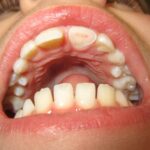
It has been estimated that around 1 billion people have been affected by a traumatic dental injury. In the UK around 1 in 5 children with have suffered a traumatic dental injury (TDI) to their permanent teeth by the time they leave school. Identifying the risk factors for TDI assists the development of preventive measures and a number of systematic reviews have been conducted on this topic.
This overview of systematic reviews aimed to revise, qualify and summarise the existing body of evidence on the associations and risk factors for the occurrence of traumatic dental injury.
Methods
Searches were conducted in the PubMed, Scopus, Web of Science, Lilacs/BBO, Cochrane Library and OpenGrey databases. Systematic reviews that investigated patients with and without the presentation of factors relating to TDI and these factors’ association with TDI episodes as primary or secondary outcomes were considered. Three reviewers independently assessed the studies and extracted data. Review quality was assessed using AMSTAR 2 ( https://www.bmj.com/content/358/bmj.j4008) . When the findings of the systematic reviews were discordant the Jadad decision algorithm was applied.
Results
- 19 systematic reviews were included.
- The reviews included 249 cross-sectional, 34 epidemiological surveys, 22 cohort, 9 case-control, 4 longitudinal, 3 ecological and 30 of unspecified design.
- 14 presented meta-analyses but only 4 assessed the quality of evidence.
- 4 reviews were considered to be of moderate quality, 4 critically low and the remainder of low quality.
- The number of databases searched ranged from one to seven.
- 22 risk factors were evaluated including a range of sociodemographic factors, clinical factors, behaviours (physical activity, alcohol use, drug use), sports habits, special needs status, use of lip and/or tongue piercings and previous history of TDI.
- Male gender, child age, greater overjet, inadequate lip coverage, anterior open bite, caries in the permanent dentition, overweight, a previous history of TDI, tongue piercing, the use of alcoholic beverages and participation in sports were all associated with a greater risk of TDI.
Conclusions
The authors concluded: –
Sociodemographic, clinical and environmental factors are associated with a greater chance of TDI occurrence. However, most of the systematic reviews included were of a low quality and may not provide an accurate and comprehensive summary of the available research that addresses the question of interest. Well-designed primary studies on different aspects of TDI are encouraged to provide higher quality scientific evidence.
Comments
We have previously considered a number of reviews related to TDI in this blog (other references). This overview of systematic reviews on the topic aimed to summarise the available evidence on associations and risk factors for TDI. The reviewers searched a broad range of databases initially identifying 42 potential paper including 19 in total. Of the reviews included only 4 of them were assessed as being of moderate quality using the AMSTER 2 tool and another 4 being assessed as being of critically low quality. While the AMSTER 2 tool is widely used to assess review quality it does have some limitations, and these are discussed in the review.
All of the included reviews have been published between 1999 and 2019 and in total have included assessment of 351 studies. Many of these studies are likely to have been included in several of the included reviews. The fact that some of these reviews will have had slightly different questions and inclusion criteria does mean different subsets of papers will have been assessed. However, this still represents a large area of potential overlap and duplication of effort in terms of producing these systematic reviews. In addition, many of these reviews appear not to have closely followed currently available guidelines such as PRISMA and MOOSE. The reviews authors also point out similar issues with the primary studies not following best practice for the conduct and reporting of their chosen study design (EQUATOR Network). This is not an issue that is restricted to this field of dental research and neeeds to be addressed more broadly.
Links
Primary Paper
Magno MB, Nadelman P, Leite KLF, Ferreira DM, Pithon MM, Maia LC. Associations and risk factors for dental trauma: A systematic review of systematic reviews. Community Dent Oral Epidemiol. 2020 Sep 6. doi: 10.1111/cdoe.12574. Epub ahead of print. PMID: 32893395.
Review protocol in Open Science Frameworks
Other references
Jadad AR, Cook DJ, Browman GP. A guide to interpreting discordant systematic reviews. CMAJ. 1997 May 15;156(10):1411-6. PMID: 9164400; PMCID: PMC1227410.
Dental Elf – 15th May 2018
Dental Elf – 18th Aug 2015
Traumatic dental injury associated with overweight/obese children?
Dental Elf – 23rd Jul 2015
Traumatic dental injury in primary teeth not associated with socioeconomic status?
Dental Elf – 27th Jan 2015
Increased overjet: increases risk of dental trauma suggests review
Picture Credits
